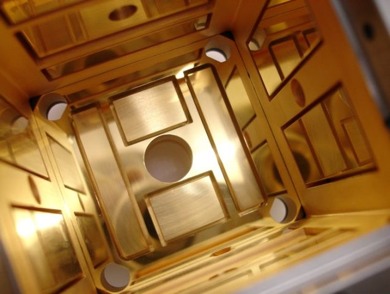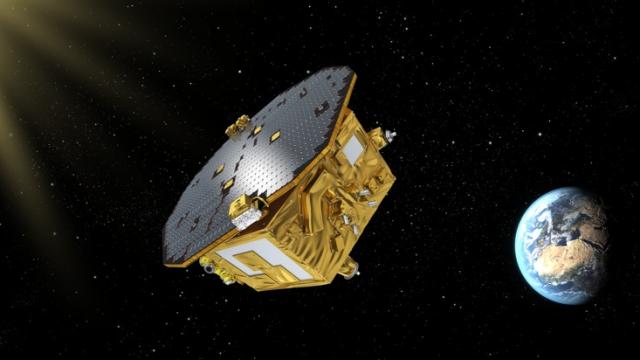A planned space-based gravitational wave observatory is one step closer to becoming a reality because a critical technological component just passed a series of tests with flying colours. The LISA Pathfinder collaboration announced the results of these experiments at a press briefing in Madrid last night, along with a paper published in Physical Review Letters.
Image: European Space Agency.
Gravitational waves are ripples in the fabric of spacetime caused by the most energetic events in the universe — supernovae, black hole mergers and the like. There’s been so much (well-deserved) excitement over LIGO’s direct direction of gravitational waves earlier this year that it’s easy to forget LIGO isn’t the only game in town. The era of gravitational wave astronomy is just beginning. There’s an entire spectrum of gravitational waves, much like there are many different kinds of light, of varying wavelengths, in the electromagnetic spectrum.
So there are other collaborations tailored to hunt waves at frequencies beyond what LIGO is designed to detect (the millisecond regime). Launched last December, the LISA Pathfinder mission is one of those collaborations. It’s the first phase of the European Space Agency’s (ESA) planned full-fledged space-based mission to detect gravitational waves, known as the Laser Interferometer Space Antenna (LISA).
“LISA bridges the gap in gravitational wave frequency between pulsar timing arrays and LIGO so it is absolutely critical if we are to characterise the full gravitational wave spectrum,” West Virginia University’s Maura Mclaughlin — who studies gravitational waves at very low frequencies, and is not a member of the LISA Pathfinder mission — told Gizmodo. “Not building it would be like having radio and gamma-ray telescopes but no infrared or optical. We need all of these to get the complete picture of sources.”
Although it is a space-based interferometer, LISA Pathfinder isn’t designed to actually detect gravitational waves. Rather, it’s a prototype observatory to test the detector technologies needed for the full-blown LISA mission. As Gizmodo’s Maddie Stone wrote last December:
Its goal is simple: using laser interferometers, the spacecraft will attempt to precisely measure the relative positions of two 5cm gold-platinum cubes in free fall. Housed in separate electrode boxes a mere 38cm apart, the test objects will be shielded from the solar wind and all other external forces, such that the tiny motions caused by gravitational waves can (hopefully) be detected…. Eventually, the ESA plans to build a large space-based observatory that takes precise measurements on test objects separated by hundreds of thousands of kilometres.
The LISA Pathfinder spacecraft has thrusters that fire as needed to ensure the cubes remain in free fall under the influence of gravity and nothing else. Even sunlight can disturb that free fall motion sufficiently to drown out any signals from gravitational waves. The mission’s scientists have spent the last few months working to understand limits on the laboratory’s measurement precision, including stray electrostatic forces, cosmic rays and even the random motion of molecules within the test masses themselves.
The results far exceeded expectations: The two cubes are in free fall and almost motionless with respect to each other, and the scientists were able to determine the distance to less than the diameter of an atom — five times better than the goal for LISA Pathfinder, according to Martin Hewitson of the Albert Einstein Institute and Leibniz Universitat Hannover.

LISA Pathfinder’s electrode housing chambers, where the positions of test masses will be precisely monitored. Image credit: CGS SpA
It’s a hugely important proof of principle, demonstrating that it is possible to implement a gravitational wave observatory in space. Mclaughlin declared it “a spectacular achievement”, adding, “This result has shown that the primary challenge has been surmounted. It would now be very surprising if LISA did not achieve its full projected sensitivity.”
The full LISA mission will consist of three spacecraft in a triangular configuration, each containing two gold-platinum cubes in free fall. Conceptually, it will work much like LIGO, using high powered lasers to measure tiny changes in the distance between those test masses. But to detect gravitational waves at such low frequencies, LISA’s three spacecraft need to be even further apart than the Earth-bound LIGO detectors in Louisiana and Hanford, Washington. LISA should also be better able to resolve directional sources of gravitational waves within an arc-second.
As for the kinds of events LISA might detect, Stefano Vitale of the University of Trento, and principal investigator for the LISA Pathfinder mission, said the most exciting thing would be capturing a small black hole falling into a supermassive black hole. The full-blown LISA observatory would enable physicists to precisely map the gravitational field around a black hole, thereby testing the predictions of general relativity to an unprecedented degree.
“The results reported by the [Lisa Pathfinder] team are, quite simply, a tour de force in precision measurement,” David Reitze, executive director of LIGO, wrote in a viewpoint for APS Physics. “[These] experiments firmly establish that the precision needed by LISA for measuring test-mass displacements are well in hand, setting the stage for the next era in gravitational wave detectors.” The ESA currently hopes to launch the full LISA mission in 2034.
